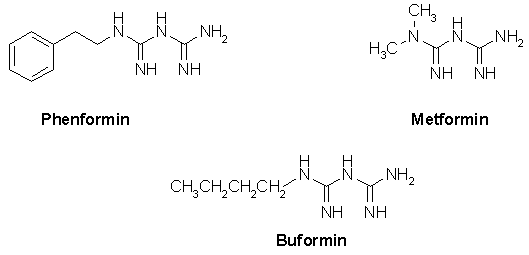
Biguanides
|
Sections |
| Introduction |
| Mechanism of Action |
| Metabolism |
| Questionnaire |
Guanidine was found to lower blood glucose levels in animals in 1918. However, it was found to be toxic precluding its use in routine medicine. Some guanidine derivatives, including synthalins A and B, that were less toxic than guanidine were introduced without much success. In the 1950s phenformin was found to have antidiabetic properties. Two other biguanides, metformin and buformin, were also introduced though not in the US market. (see figure below; click on the hyperlinks to view the three dimensional structures)

Phenformin has the potential to cause lactic acidosis, the increase in blood lactic acid levels. In the US, the death rate among phenformin users was about 50 to 700 deaths per year. This led to complete suspension of phenformin marketing in the US in 1977.
Metformin causes a small increase in peripheral lactate and has a death rate of about 0 - 0.084 per 100 patient-year. This death rate is about an order of magnitude lower than phenformin. By judicious use in patients not susceptible to renal insufficiency and cardiovascular disorders, the incidences of lactic acidosis could be minimized. Metformin is available in the US market.
In general biguanides should be used only in stable type II diabetics who are free of liver, kidney and cardiovascular problems and who cannot be controlled with diet. Biguanides can be used either alone or in combination with sulfonyl ureas.
The exact mechanism of action remains unknown. However metformin has no direct stimulatory effect on insulin release. Metformin has been shown to increase insulin binding to its receptor both in vitro and in vivo. In rat adipocytes, metrormin increases insulin-induced translocation of glucose transport proteins from an intracellular pool to plasma membrane.
The guanidinium group would be positively charged at physiological pH suggesting that biguanides would be poorly protein bound. In fact less than 20% of phenformin is protein bound. Phenformin is also para-hydroxylated and is active over 4-6 h. Metformin has an even less duration of action (1.7 - 4.5 h).
[session home] [home] [school
of pharmacy] [department of medicinal
chemistry]
©2000 VCU School of Pharmacy
Revised: January 15, 2000
Questions or Comments : Dr. Umesh
R. Desai